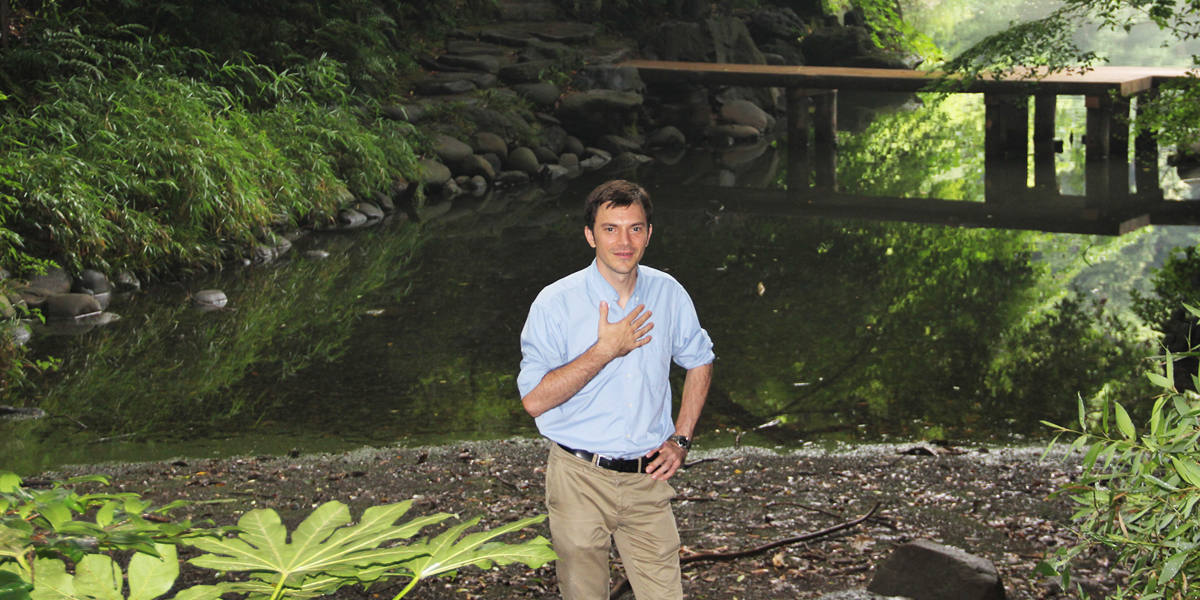
Researching the Ocean while Appreciating the Beauty of Rural Japan
-
- Robert Blasiak
- Research Fellow, Graduate School of Agricultural and Life Sciences
Areas of Study: Ocean Management and International Cooperation
Country/Region of Origin: the United States
Drifting towards Japan
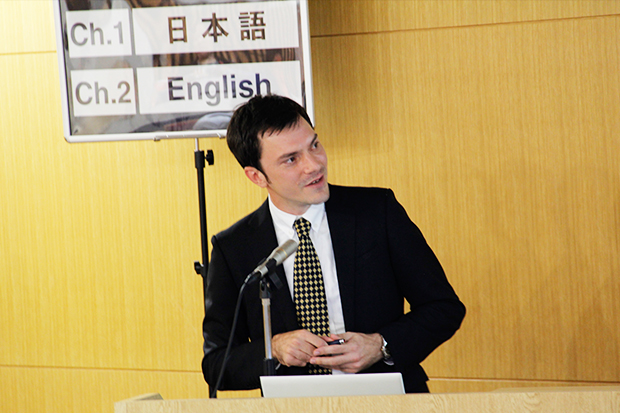 Giving a presentation at the Regional Applications and Nexus of the Ocean Health Index symposium
Giving a presentation at the Regional Applications and Nexus of the Ocean Health Index symposium
I was born in New York and raised in Louisiana in the United States. I first came to Japan six years ago. Before that I had enrolled in a Master’s program at Lund University in Sweden and studied international development. More specifically, I used game theory to research cooperation in the international development community in Cambodia. It’s an interest that goes all the way back to when I was an undergraduate student at the University of Massachusetts at Amherst, where I studied mathematics. By the way, when I was studying at Lund University, I met my wife, who is Japanese.
Mere accident or serendipity?
When we graduated from Lund University, my wife and I both started applying for jobs. I applied for 40 to 50 different jobs with international organizations around the world, but got no offers at all. My wife, meanwhile, applied for two jobs in Japan and was offered both! But I also work as a freelance German-to-English translator, which gives me some flexibility, so we decided to come to Japan. For the first two years, we lived in Nagoya while my wife was working at Nagoya University, and I taught German at Nanzan University while doing translation work. Afterwards, we moved to Yokohama when I got a job at the United Nations University to work with satoyama and satoumi (the traditional mosaic landscapes and seascapes of Japan). Now I work as a Research Fellow at the University of Tokyo, but I also continue to cooperate with the UN University, where I am currently involved with a number of projects including the Fukushima Global Communications Programme and the Water and Urban Initiative.
Why did I come to UTokyo? Well, it was kind of an accident, actually (laughs). By chance, I met Professor Yagi, who is my supervisor now, in a taxi in Hyderabad, India. Professor Yagi is knowledgeable not only about Japan’s satoumi but also about the international policies related to fisheries management. We began talking with each other about satoumi and marine resources, and when I found out several months later about an opening for a Research Fellow in the same lab, I applied for the position. Now I’ve been working at UTokyo for about one and a half years.
Of research and bread-making
At UTokyo, I work as a Research Fellow while also studying with the aim of obtaining a Doctoral degree. My main research is on international cooperation for sustainable management of fisheries and marine resources. At the same time, to complete the degree, I have to contribute at least three articles to peer-reviewed academic journals. Right now I am writing a dissertation based on several articles I’ve published, and I hope to complete it soon. If I can successfully defend my dissertation, then I will get the degree as well. A nice thing about UTokyo is that it offers not only structured Doctoral programs, but also more independent programs like in my case in which you can get a Doctoral degree while working as a researcher.
I have two main research interests. One is the analysis of international cooperation for sustainable management of fisheries and marine resources, as I mentioned before. The other is to research people’s perceptions of marine ecosystems. I want to investigate how people perceive the benefits and value they get from the ocean, and utilize my findings to propose more appropriate ocean management policies. Earlier this month, the University of Tokyo hosted a symposium titled Regional Applications and Nexus of the Ocean Health Index, where I gave a presentation on “Public Perceptions of the Value of Ocean Ecosystem Services.” I want to continue to present my research findings at international symposiums and through journals. International meetings, in particular, provide a very rewarding opportunity to speak with researchers from all around the world who share similar interests. I have found that in general, while people may differ on their approaches to ocean management, the majority have good intentions with regards to the usage of marine resources. Despite this, ocean management policies around the world are currently inadequate, and I am trying to better understand why this discrepancy exists and to recommend potential solutions. In many ways, the oceans are a global commons, so to resolve ocean-related issues, the international community must work together. Although I am studying ocean management policies from all over the world, I have a specific interest in the Northern Pacific, as this is one of the richest fishing areas in the world and is also beset with numerous territorial disputes involving its waters. Currently, I am studying these issues through an innovative five-year UTokyo project called the New Ocean Paradigm on Its Biogeochemistry, Ecosystem and Sustainable Use (NEOPS).
I’m not completely sure what I’m going to do after I get my Doctoral degree (laughs)! To tell the truth, all I can think about right now is our son, who will be born later this month, and it’s a little tough to focus on anything else. My top priority has always been my family and friends. That being said, I would like to contribute to society by working in the field of international cooperation and helping to communicate key issues in an accessible and accurate manner. As for where I will work… well, that’s a big question! As an American, I feel very close to the United States, but I also like living in Japan. My wife feels the same way. We are considering where the easiest place would be for us to live. One possible plan is to stay in Japan and continue with my research at the University of Tokyo or the United Nations University. UTokyo has a lot of connections with international institutes and renowned universities around the world, which would allow me to pursue international research. In my experience, the University’s academic and administrative staff have been warm and kind, and very easy to work with. There are many specialized libraries scattered across the University, and there are lots of non-Japanese materials available. I think the University of Tokyo provides a good environment for researchers.
By the way, I have really gotten into making bread recently, although many of my friends tease me about it. Making bread out of very basic ingredients is really satisfying. It takes time—sometimes several days—to make good bread, but you end up with something you can eat at the end of it (laughs). In the case of international cooperation, I sometimes wonder whether my efforts have any impact. Making bread, on the other hand, always produces tangible results. Since childhood, I have been interested in making bread, but my first efforts were all complete failures. One day, I watched a Werner Herzog documentary about mountain climbers in the Himalayas and saw a Sherpa guide sitting outside his tent in the middle of nowhere, making bread with almost no utensils or equipment. I thought that if that guy can make bread, then so can I! And now I can. Anyway, I prefer work using my hands to sitting in front of the computer all day.
My “Walk in Japan” and UTokyo
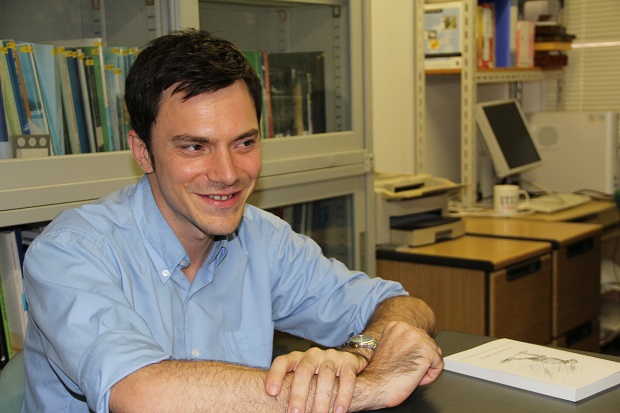
My first impression of Japan was how cold it was (laughs). The first time I came was in December six years ago, when I visited my wife’s parents in Fukushima Prefecture. Because the house was completely unheated except for one room and I had just arrived from Cambodia, it was very cold to me. But the family is very warm and hospitable. Also, I was very impressed with the beautiful landscapes of Fukushima, and I still think that Fukushima is one of the most beautiful areas in Japan.
Yokohama, a town with a foreign flavor
Now I live in Yokohama. For me, Tokyo is too big. There are too many people and not enough nature, aside from the Meiji Shrine and a few other hidden gems. I feel more relaxed in Yokohama even though several million people live there. The port has been beautifully designed though, giving those parts of the city a unique and attractive atmosphere which is much more family-friendly. Every time Yokohama experienced disasters, it was systematically redeveloped, and an attractive cityscape rooted in history has been created. Yokohama was also one of the first cities that Japan opened to foreigners. My apartment is located in the Kannai area. At the end of the Edo period, this area was a man-made island that was kept separate for foreigners (to enter or exit this island, foreigners had to pass through kanmon, or checkpoints; Kannai means “inside the kanmon”). I like to think that I’m still living in the right place (laughs).
Sanshiro Pond, a green oasis in the heart of the University
My first impression of UTokyo was from Professor Yagi whom I met in India and also from Professor Kurokura, who has worked here for many years. Both have been very kind to me and they have welcomed many international researchers and students into the lab. They are firmly committed to establishing and strengthening connections with institutions and academics from Japan and a wide variety of different countries as diverse as Cambodia, the Philippines and tiny islands in the Caribbean. But in the end, what makes it possible to work or study at UTokyo is the administrative staff, who keep the University running smoothly. I have been especially lucky in the lab where I work, because the staff member in charge of logistics and administrative work speaks excellent English and has been incredibly kind and helpful since my very first day. I am very grateful to the professors, the staff and all the researchers and students around me. My favorite spot in UTokyo is Sanshiro Pond on the Hongo Campus. It is just unbelievable that this kind of green oasis sits in the middle of a university in the heart of a city. There are so many different species of trees and plants, and of course a lot of fish in the pond. If you sit quietly on a bench there, you can see kingfishers and even parakeets. When I saw parakeets there for the first time, I was surprised because I never thought I would see tropical birds like that in the middle of Tokyo. I did a little research and discovered that parakeets were once imported from India as popular pets in Japan, but many would be set free because their owners had trouble taking care of them. The released parakeets eventually formed a breeding population, and some of them come to Sanshiro Pond. Anyway, the thing that surprises me about Sanshiro Pond is that only a handful of people visit there, although it is the most beautiful location on the Hongo Campus. It is a quiet place, and I can feel very relaxed while I’m there.
Satoyama, the beauty of Japan
After settling here, I have had many opportunities to visit places in rural Japan, like the Tohoku region, Ishikawa and Nagano. Of course, Tokyo has many tourist sites, like the Meiji Shrine and Tokyo Skytree. But my advice for those who will visit Japan is to make sure to take a trip to rural areas because you can encounter rich nature and the warmest people there. Satoyama are formed from the linkages and interactions between people and the landscapes that surround them—nature shapes people and cultures, and cultures shape landscapes. These fundamental linkages are disappearing in Tokyo, but many rural areas still maintain these traditions.
Polishing My Rough Edges
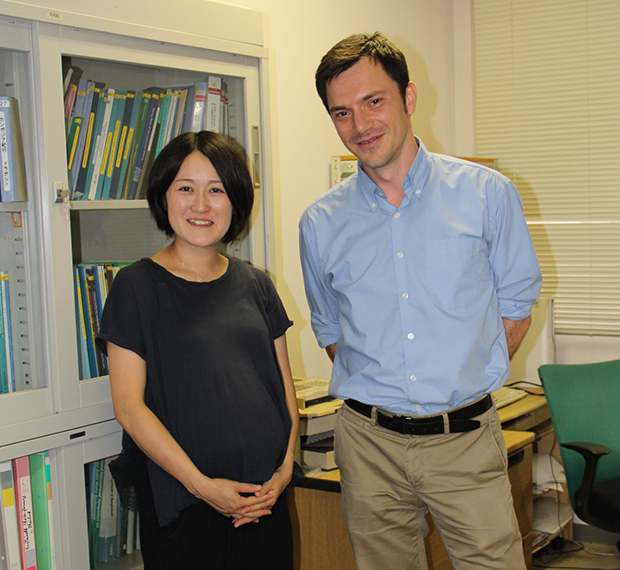 Robert with one of the kind and helpful staff members
Robert with one of the kind and helpful staff members
One thing that amazes me in Japan is the courier and delivery services. These companies and the post office are incredibly efficient and the delivery people are usually cheerful and seem to take pride in their jobs. Japanese postage stamps are also beautiful, and I like sending letters and postcards to friends overseas. One challenge of living here, however, is that bank service fees in Japan are very high. Since most of my translation work is for clients overseas, I end up having to pay thousands of yen every time they send money to my bank account in Japan.
Warm people are always around
As for UTokyo, I have no troubles at all, not even with all the different layers of complex administrative procedures, because the staff I work with are extremely kind, dependable and always helpful. It is good to work with people like this who always have answers to every question!
I speak basic Japanese, but it is a challenge. I’ve taken several courses at the Center for Japanese Language on the Hongo Campus. At times, however, I become very busy with overseas travel and research, so I’ve ended up missing a lot of classes. Sometimes I study Japanese by myself during my commute from Yokohama to Tokyo. Some Japanese people are comfortable with English, but not many. The good thing is that almost everyone I’ve met has been quite patient with me if I have to speak Japanese (laughs). This is especially true in rural Japan, where the great hospitality and warmth of the country can be found.
Like stones in a bag
What has changed about me since I came to Japan? Well, I’ve started cutting my hair shorter because Japanese summers are very hot and humid (laughs). All joking aside, when I was a Master’s student at Lund University, I did fieldwork on international development in Cambodia. There is a saying among Buddhist monks there: “Monks living together in a pagoda are like stones in a bag; over time, the close contact rubs away all the rough edges, leaving behind beautifully polished stones.” In the United States, very strong emphasis is placed on individualism. Meanwhile, in Japan, people seem to focus first and foremost on keeping harmony within the community. Although individualism is part of my personality as an American, I am also attracted to Japanese society. By living in such a society, perhaps my rough edges are being rubbed and polished away. By the way, commuter trains in Tokyo are ideal places for getting polished quickly, since you’re in close contact with a lot of people (laughs). Well, to be fair, that’s not just a Tokyo thing—busy trains in all big cities around the world are probably like that. They are a microcosm of humanity, where the best and the worst of the society is on display. I think it’s kind of like survival of the fittest in there (laughs).
Finally, I would like to give some advice for those who want to work as researchers at the University of Tokyo. First, you should know what your interests are. Because supervisors tend to be really busy, you have to know your areas of interest so you can engage in productive research on your own. Knowing your interests allows you to conduct your research more independently and resiliently. The other piece of advice I have is… well… “Get out of Tokyo, and get to know the beauty of rural Japan!” (laughs) Of course, Tokyo is interesting, but I think the countryside is where the heart of Japan is the most vibrant and alive.
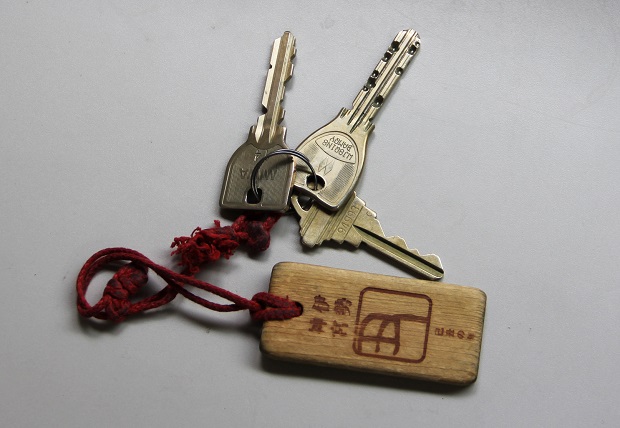
Home is Where the Key is
Key to his parents’ house
Robert brought us the key to his family’s house in the U.S. The keychain is a lucky charm that he was given at the Ise Shrine. He explains that the red string indicates that he was a visitor from overseas, while Japanese are given strings of different colors. For over 15 years, Robert has been overseas, and every day he has carried the key to his family’s home in his pocket. The first thing he does when he returns to the U.S. is to open the door to his family’s house in Massachusetts with this key. He says he misses his father’s woodworking shop and garden. He dreams of hiking in the forests of Massachusetts, and making bread with his wife and son in the future.
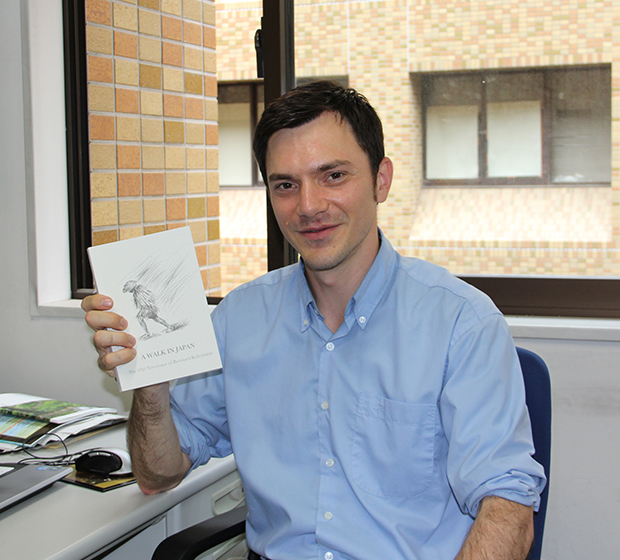
A Walk in Japan
Translating a 100+ year-old German travelogue about Japan
Robert had a fateful encounter with a book titled Ein Spaziergang in Japan in Germany. He happened to find the book in a secondhand bookstore in Heidelberg. It had been written by a young German man named Bernhard Kellermann about his six-month trip to Japan in 1910. When Robert opened the book, the first thing he saw was a chapter about Yokohama. It depicts a bustling street scene in Yokohama, and Robert immediately recognized the name of the street because it is in the same neighborhood where he currently lives. He wanted to share this chapter with his family and friends, but an English translation did not exist, so he started translating the book from German to English. The English version of the book (A Walk in Japan: The 1910 Travelogue of Bernhard Kellermann) is a travelogue about Japan and Kellermann’s encounters with Japanese people. It was published in mid-2015 with illustrations by Tokyo-based illustrator Stuart Ayre. Regarding his work as a German-to-English translator, Robert says he started studying German when he was an undergraduate student. He went to Germany as an exchange student and stayed there for several years. He says he was very lucky to have made lifelong friends in Germany and to have learned the German language, which he continues to use as a translator today.





